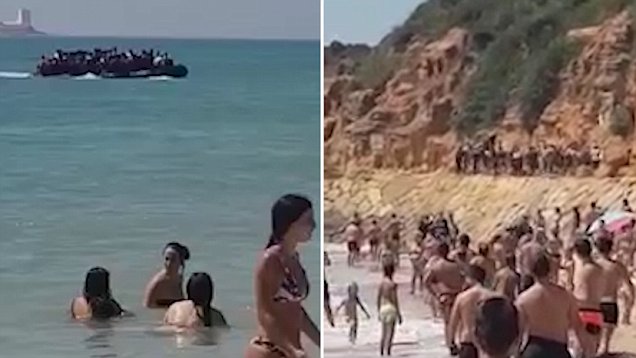‘They’re heading for the all-inclusive’: Stunned tourists watch 50 migrants storm Spanish beach

- Clip shows packed semi-inflatable vessel beaching near luxury hotel in Spain
- Tourists watched open-mouthed as migrants poured on to beach and up cliffs
- Incident filmed on Barrosa Beach in southern Spain’s Costa de la Luz on Sunday
- Spain has overtaken Italy as preferred destination for migrant arrivals in Europe
This is the astonishing moment migrants stormed a packed tourist beach and clambered up a cliff after jumping off their boat in southern Spain.
Holidaymakers watched open-mouthed as the semi-inflatable Zodiac carrying around 50 Moroccans – including about ten children – beached near a luxury hotel area on Spain’s Costa de la Luz.
Footage shows refugees sprinting up the popular Barrosa Beach at about 3.30pm on Sunday before attempting to scale cliffs.
The incident happened near a purpose-built residential and tourist resort called Sancti Petri which boasts shops, restaurants and several four and five-star hotels.
A tourist filming the scene could be heard saying in Spanish as the migrants leapt from their boat: ‘Look how they’re running towards the Sancti Petri Melia Hotel. They’re heading for the all-inclusive Melia Sancti Petri. Look, look, look.’


Astonishing footage captures the moment a group of African migrants stormed a packed tourist beach and jumped off their boat before clambering up cliffs in southern Spain

The incident happened around 3.30pm on Sunday at Barrosa Beach, considered to be one of the best beaches on Spain’s southern coast
A witness, who told how beachgoers took mobiles that had been left in the boat, added: ‘We thought they weren’t going to reach the beach because it’s not something that’s normal in this area, but they leapt off the Zodiac very quickly and began to climb up the rocks.’
Civil Guard officers said this morning 25 of the migrants had been intercepted – 19 of whom were minors. They said all were Moroccans.
A spokesman for the force said the six adults would be taken to an adult migrant holding centre before being returned to their country of origin as part of an agreement with Morocco.
He said the 19 minors, whose ages he could not specify, would be taken to youth centres run by the regional Junta de Andalucia government.
He said: ‘None of those intercepted have been arrested as they haven’t committed a crime. They will be dealt with differently depending on whether they are adults or minors.
‘The minors will be taken to youth centres and the adults to a secure migrant holding centre called a CIE.
‘The return of the adults to their country of origin will be fairly quick.’
Sources said the minors would remain in Spain. One said: ‘We don’t know exactly how many people were on the boat but it’s obvious a number of the migrants managed to get away undetected.

The incident happened near a purpose-built residential and tourist resort called Sancti Petri which boasts shops, restaurants and several four and five-star hotels


Tourists were swimming in the sea and sunbathing when the packed vessel arrived at the beach


Holidaymakers watched open-mouthed as the semi-inflatable Zodiac carrying nearly 50 Moroccans including about ten children beached near a luxury hotel area on Spain’s Costa de la Luz
‘The authorities are still looking for them.’
Last month around 50 migrants were filmed landing on a packed beach and sprinting up the sand at a beach in Zahora a half-hour drive away and close to the headland of Cape Trafalgar near where Horatio Nelson defeated Napoleon’s combined Spanish and French fleet.
The men and women videoed jumping from the rickety wooden boat known as a patera in the July 28 arrival, were from sub-Saharan Africa.
Days earlier, dozens of migrants were filmed storming another southern Spanish beach as confused sunbathing nudists watched on.
The dramatic clip, taken on the beach at Tarifa, showed a group of more than 30 migrants landing in a dinghy before sprinting off into woodland surrounding the beach to evade the pursuing Spanish border guards.
Spain has overtaken Italy as the preferred destination for migrant arrivals in Europe this year after Italy’s new hardline Interior Minister Matteo Salvini introduced a blanket ban on migrant boats entering the country’s ports.
The number of migrants and refugees using the western Mediterranean route to reach Spain stood at 20,992 between January 1 and July 25 according to the IOM, close to the 22,108 people who used it during the whole of last year.
Coastguards rescued more than 60 migrants in the Gibraltar Straits yesterday – 28 less than on Saturday when 88 migrants were rescued.
Meanwhile, Spain last week sent 116 migrants back to Morocco after they entered the country illegally.
Deputy Prime Minister Carmen Calvo said a 1992 agreement with Rabat had been activated to expel the migrants.
It came after the refugees used what she described as ‘unacceptable’ violence when storming fences separating Spain’s North African enclave of Ceuta from Morocco on Wednesday. Seven policemen were hurt in the incident.
Calvo said Spain would keep receiving migrants rescued in the Mediterranean in a ‘safe and humanitarian’ manner.
Sub-Saharan Africans living illegally in Morocco often try to enter Europe by scaling fences surrounding Ceuta and Melilla, Spain’s other North African enclave.
Migrant arrivals in Spain have spiked in recent months, placing strain on public services and putting political pressure on the government.


